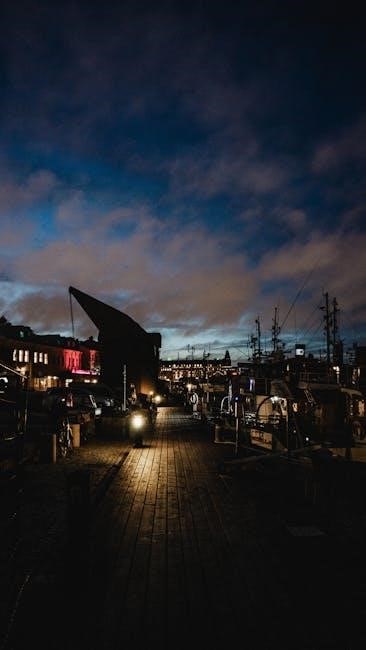Navigation lights are essential for maritime safety, providing visual signals to prevent collisions and ensure safe passage. They indicate a vessel’s position, direction, and status, aiding communication between ships.
1.1 Importance of Navigation Lights in Maritime Safety
Navigation lights are critical for preventing collisions and ensuring safe navigation. They provide visual signals that help other vessels understand a ship’s position, direction, and status. Navigation lights reduce the risk of accidents by enhancing situational awareness, especially at night or in low visibility. Compliance with international regulations ensures consistency across all vessels, promoting maritime safety globally. These lights are essential for clear communication between ships, aiding in the prevention of misunderstandings that could lead to dangerous situations. Their proper use is vital for maintaining order and safety at sea.
1.2 Brief History of Navigation Lights
The use of navigation lights dates back to ancient maritime practices, with early civilizations employing torches and lanterns to signal a vessel’s presence. Over time, these primitive methods evolved into standardized systems. In the 19th century, formal regulations were established to ensure uniformity, culminating in the International Maritime Organization (IMO) regulations. Modern navigation lights incorporate advanced technologies like LED lighting, improving visibility and efficiency. This historical development reflects the ongoing commitment to enhancing maritime safety and reducing the risk of collisions at sea.
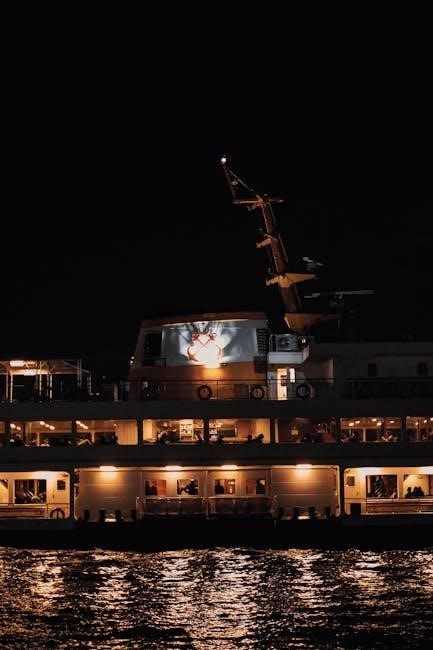
Types of Navigation Lights
Navigation lights are categorized into masthead, sidelights, stern lights, and all-round lights, each serving distinct roles in indicating a vessel’s position, direction, and operational status at sea.
2.1 Masthead Lights
Masthead lights are mounted forward on a vessel and emit a white light. They are mandatory for power-driven vessels and indicate the ship’s direction. The masthead light on vessels over 50 meters must be visible for six nautical miles, while smaller vessels have reduced visibility requirements. Proper installation ensures compliance with maritime regulations, enhancing safety and communication at sea. Regular maintenance is essential to maintain their functionality and visibility, ensuring they perform reliably in all conditions.
2.2 Sidelights
Sidelights are colored navigation lights indicating a vessel’s direction. Green lights are shown on the starboard (right) side, while red lights are displayed on the port (left) side. These lights are crucial for determining another vessel’s relative position and course. Sidelights must be visible for three nautical miles and are essential for preventing collisions. Proper installation and maintenance ensure they function correctly, adhering to maritime safety standards. Their clear visibility aids in communication between ships, enhancing overall navigation safety at sea.
2.3 Stern Lights
Stern lights are white navigation lights displayed at the rear of a vessel, indicating its direction and position. They are typically positioned above the waterline and are visible from all directions. Vessels over 50 meters are required to display two stern lights vertically, ensuring a clear visual signal. These lights must be visible for at least 2 nautical miles and are essential for safe navigation, especially in low visibility or darkness. Proper installation and maintenance are crucial to ensure compliance with maritime regulations and prevent collisions. Stern lights play a vital role in enhancing navigational safety at sea.
2.4 All-Round Lights
All-round lights are navigation lights visible from any direction, typically displayed at the masthead or stern. They emit a 360-degree light and are crucial for indicating a vessel’s status, such as being at anchor or under tow. These lights are often white but can vary in color depending on the vessel’s operation. For example, a vessel at anchor uses all-round white lights, while a fishing vessel may use a combination of all-round and colored lights. Proper positioning ensures maximum visibility, adhering to maritime regulations to enhance safety and prevent collisions, especially in low-visibility conditions or at night.
Legal and Regulatory Requirements
Navigation lights must comply with IMO regulations, specifying visibility ranges, colors, and installation standards. Adherence ensures maritime safety and legal compliance globally, reducing collision risks.
3.1 International Maritime Organization (IMO) Regulations
The International Maritime Organization (IMO) sets mandatory standards for navigation lights to ensure safety at sea. These regulations outline specific requirements for the visibility, color, and positioning of lights on vessels. For instance, masthead lights must be visible from a minimum distance of six nautical miles, while sidelights and stern lights have different visibility ranges. IMO rules also specify the technical standards for light intensity, ensuring that all vessels meet uniform safety criteria. Compliance with these regulations is crucial for preventing collisions and maintaining maritime safety worldwide.
3.2 Specific Requirements for Vessels of Different Sizes
Navigation light requirements vary based on vessel size and type. Vessels under 50 meters must display simplified lighting, while larger vessels require more complex systems. For example, vessels over 50 meters need two masthead lights, whereas smaller vessels may use a single masthead light. Sailing vessels and small craft, such as those under 20 meters, have specific exemptions and may use alternative lighting configurations. These regulations ensure safety while accommodating the operational needs of different vessel sizes, promoting uniformity across the maritime industry.
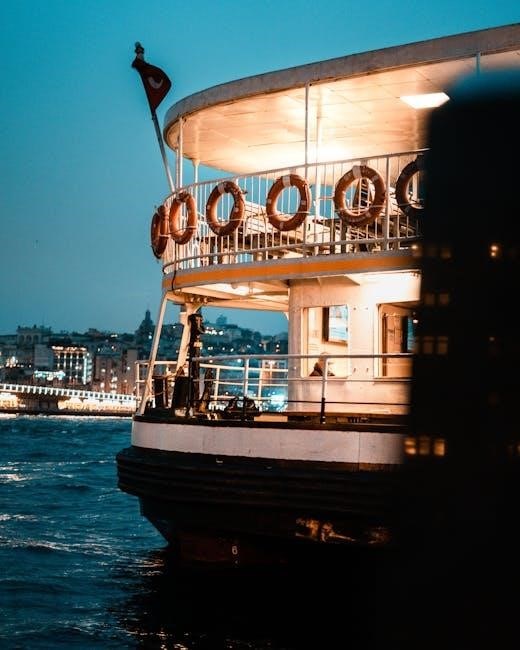
Installation and Maintenance
Proper installation of navigation lights ensures compliance with maritime regulations. Regular maintenance, including bulb replacements and wiring checks, is crucial for reliable operation and safety at sea.
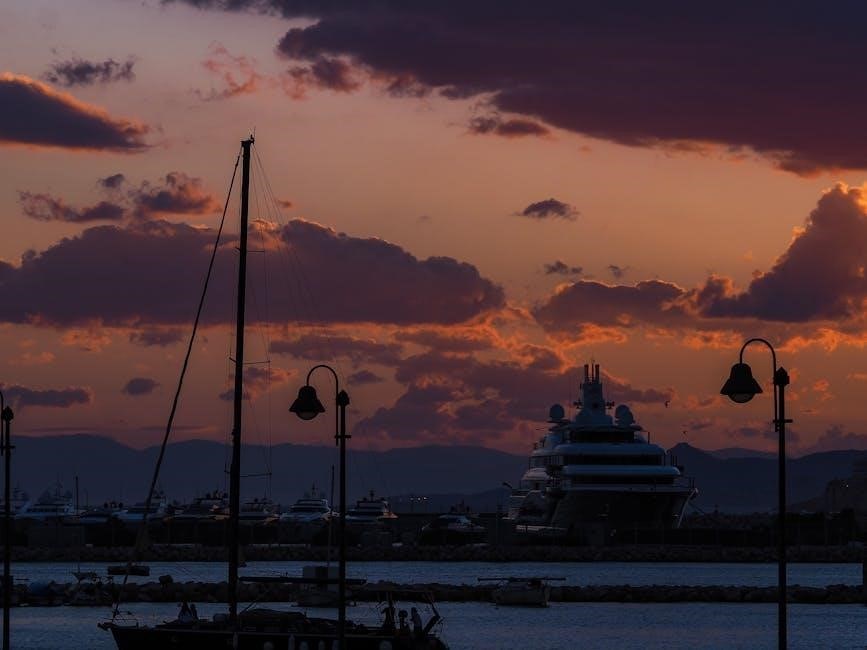
4.1 Proper Installation Techniques
Proper installation of navigation lights ensures compliance with maritime regulations and safety standards. Masthead lights, sidelights, and stern lights must be mounted at correct heights and angles to maintain visibility. Tools like wrenches for M10 bolts are essential for securing fixtures to masts or structures. Electrical connections should adhere to IMO regulations, ensuring watertight and corrosion-resistant installations. Proper alignment of lights is crucial for accurate visibility ranges. Regular checks during installation guarantee reliable operation, preventing potential hazards at sea. Adhering to these techniques ensures vessels meet legal requirements and maintain safety in all conditions.
4.2 Tools and Materials Needed
Installing navigation lights requires specific tools and materials to ensure proper functionality and compliance. Essential tools include wrenches for securing M10 bolts, screwdrivers, and drills for mounting hardware. Marine-grade fasteners and electrical connectors are necessary for durable installations. LED navigation lights, resistant to corrosion, are preferred for longevity. Additional materials like circuit diagrams and installation guides aid in correct setup. High-quality, watertight components ensure reliability in harsh marine environments. Adhering to these requirements guarantees safe and efficient navigation light systems, meeting IMO standards for maritime safety.
4.3 Regular Maintenance Practices
Regular maintenance of navigation lights is critical to ensure reliability and compliance with safety standards. This includes inspecting lenses for cleanliness and damage, checking electrical connections for corrosion, and verifying that all lights function correctly. LED lights, preferred for their longevity, should still be tested periodically. Watertight components must be inspected to prevent water ingress. Additionally, ensure that all lights meet visibility requirements and are free from obstructions. Routine maintenance prevents failures and ensures uninterrupted safe navigation, adhering to IMO regulations and maintaining maritime safety standards effectively.
Special Cases and Exceptions
Special cases include vessels under 50 meters, those at anchor, and small craft, with specific lighting requirements to ensure safety and compliance with maritime regulations.
5.1 Vessels Under 50 Metres
Vessels under 50 metres have simplified lighting requirements. They must display a single all-round white light when at anchor, ensuring visibility to other vessels. Power-driven vessels under this length may use combined masthead and sidelights, while sailing vessels can use alternative configurations. Small craft, such as those under 7 metres, may use a torch or lantern showing a white light. These exceptions ensure safety without unnecessary complexity, accommodating smaller vessels’ operational needs while maintaining compliance with maritime safety standards.
5.2 Vessels at Anchor
Vessels at anchor must display specific navigation lights to indicate their stationary status. Under 50 metres, a single all-round white light is required, while vessels over 50 metres must show two white lights, one higher than the other. These lights ensure visibility and prevent collisions by signaling the vessel’s anchored position. The lights must comply with IMO regulations, ensuring clarity and safety for nearby ships. Proper display of these lights is crucial for maintaining maritime safety standards and avoiding accidents in low-visibility conditions.
5.3 Sailing Vessels and Small Craft
Sailing vessels and small craft have specific requirements for navigation lights. Sailboats under 20 meters can display lights in configurations shown in Figures 3 or 4, combining masthead, sidelights, and stern lights. Vessels under 7 meters or capable of less than 7 knots must show a single all-round white light. Small craft, such as those under oars, should have a torch or lantern ready to display a white light to prevent collisions. These rules ensure visibility and safety, adapting to the unique needs of smaller and non-powered vessels while maintaining compliance with maritime regulations.
Navigation lights are critical for maritime safety, ensuring vessels are visible and their movements clear. Adhering to regulations and proper installation is essential for safe navigation and collision prevention.
6.1 Summary of Key Points
Navigation lights are vital for maritime safety, preventing collisions by indicating a vessel’s position, direction, and status. Proper installation and maintenance ensure reliability, while adherence to IMO regulations guarantees compliance. Different light types, such as masthead, sidelights, and stern lights, serve specific roles in signaling. Vessels of varying sizes and purposes, including those under 50 meters or at anchor, must follow tailored requirements. Special cases, like sailing vessels, have unique lighting rules. Future advancements in LED technology and smart systems aim to enhance safety and efficiency in navigation lighting systems globally.
6.2 Future Developments in Navigation Lighting
Future advancements in navigation lighting focus on enhancing safety, efficiency, and environmental sustainability. LED technology continues to evolve, offering longer lifespans and lower power consumption. Smart systems with automated monitoring and control are being developed to reduce human error and improve reliability. Innovations in materials and designs aim to withstand harsh maritime conditions better. Additionally, eco-friendly solutions, such as solar-powered lights, are gaining traction. These developments ensure navigation lights remain a critical tool in modern maritime operations, adapting to the demands of a rapidly changing industry while maintaining compliance with global safety standards.
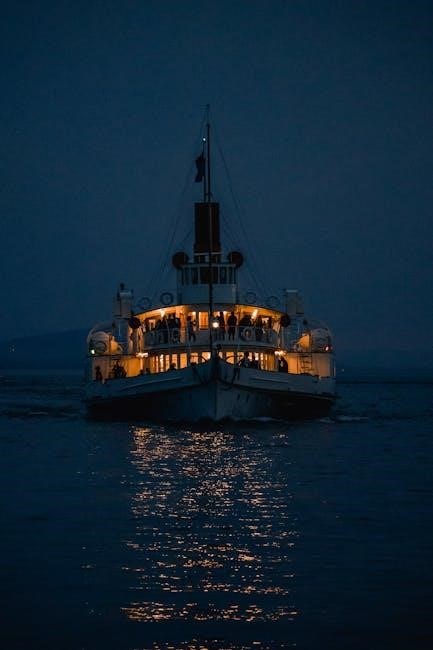
References and Further Reading
Key resources include IMO publications, such as the Convention on International Maritime Safety, and specific guides like “An Essential Guide to Navigation Lights.” Additional PDFs, such as those from Australia’s Maritime Safety Queensland, provide detailed requirements and diagrams for proper navigation light configurations. These documents are essential for understanding and implementing safe maritime practices.
7.1 Relevant PDF Resources and Guides
Several PDF resources provide comprehensive guidance on navigation lights. “An Essential Guide to Navigation Lights 2014” outlines requirements and configurations. Maritime Safety Queensland offers detailed diagrams and regulations. The IMO publishes specific guidelines for vessel lighting systems, ensuring compliance with international standards. Additionally, resources like “Navigation Lights for Ships” provide installation and maintenance tips. These PDFs are invaluable for mariners, shipowners, and professionals seeking to understand and implement correct navigation lighting practices. They cover legal, technical, and practical aspects, ensuring safe maritime operations worldwide.
7.2 International Maritime Organization (IMO) Publications
The IMO provides authoritative publications on navigation lights, ensuring compliance with international maritime laws. Key documents include “Navigation Lights and Shapes,” detailing requirements for vessel visibility and signaling. The IMO’s “Convention on the International Regulations for Preventing Collisions at Sea” outlines specific lighting standards. These publications guide the installation, maintenance, and operation of navigation lights, ensuring safety and uniformity across the globe. They are essential resources for shipowners, operators, and maritime professionals to adhere to legal and safety standards effectively.
